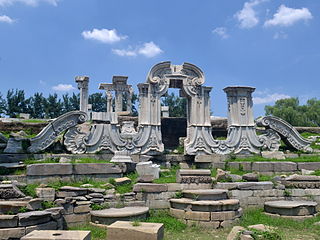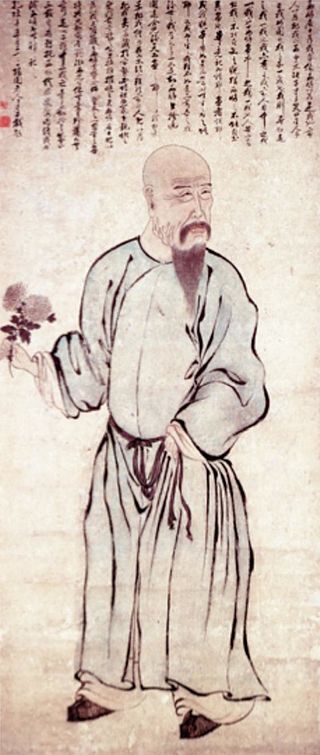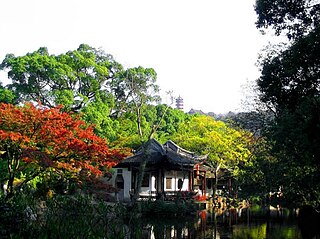
This is a list of Chinese-style gardens both within China and elsewhere in the world.

This is a list of Chinese-style gardens both within China and elsewhere in the world.
This list is organized by region within the Greater China region, roughly following the structure laid out by Maggie Keswick in The Chinese Garden. The names of Chinese gardens are very problematic in English; this list aims to capture all the major variants, both in Chinese and in English.







https://hamiltongardens.co.nz/collections/paradise-collection/chinese-scholars-garden/

Beijing cuisine, also known as Jing cuisine, Mandarin cuisine and Peking cuisine and formerly as Beiping cuisine, is the local cuisine of Beijing, the national capital of China.

The Old Summer Palace, also known as Yuanmingyuan or Yuanmingyuan Park, originally called the Imperial Gardens, and sometimes called the Winter Palace, was a complex of palaces and gardens in present-day Haidian District, Beijing, China. It is 8 kilometres (5 mi) north-west of the walls of the former Imperial City section of Beijing. Widely perceived as the pinnacle work of Chinese imperial garden and palace design, the Old Summer Palace was known for its extensive collection of gardens, its building architecture and numerous art and historical treasures. Constructed throughout the 18th and early 19th centuries, the Old Summer Palace was the main imperial residence of the Qianlong Emperor of the Qing dynasty and his successors, and where they handled state affairs; the Forbidden City was used for formal ceremonies. The Garden was reputed as the "Garden of Gardens" in its heyday was "arguably the greatest concentration of historic treasures in the world, dating and representing a full 5,000 years of an ancient civilization", according to Robert McGee, chaplain to the British forces.

The Englischer Garten is a large public park in the centre of Munich, Bavaria, stretching from the city centre to the northeastern city limits. It was created in 1789 by Sir Benjamin Thompson (1753–1814), later Count Rumford, for Prince Charles Theodore, Elector of Bavaria. Thompson's successors, Reinhard von Werneck (1757–1842) and Friedrich Ludwig von Sckell (1750–1823), advisers on the project from its beginning, both extended and improved the park.

Yuan Mei was a Chinese poet of the Qing Dynasty. He was often mentioned with Ji Yun as the "Nan Yuan Bei Ji".

Sheung Shui is an area in the New Territories, Hong Kong. Sheung Shui Town, a part of this area, is part of the Fanling–Sheung Shui New Town in the North District of Hong Kong. Fanling Town is to its southeast.

Sha Tin, also spelt Shatin, is a neighbourhood along Shing Mun River in the eastern New Territories, Hong Kong. Administratively, it is part of the Sha Tin District. Sha Tin is one of the neighbourhoods of the Sha Tin New Town project.
China Table Tennis Super League is the top table tennis division under the Chinese Table Tennis Association.

Zeng is a Chinese family name. In Cantonese, it is Tsang; In Wade–Giles, such as those in Taiwan, Tseng or Tzeng; in Malaysia and Singapore, Tsen, Chen or Cheng; in the Philippines, Chan; in Indonesia, Tjan; in Vietnam, Tăng. The surname Zeng is the 32nd most common surname in Mainland China as of 2019. It is the 16th most common surname in Taiwan. It meant "high" or "add" in ancient Chinese. Zeng was listed 385th on the Hundred Family Surnames.

Xu Garden, also known as the West Garden and by other names, is a Chinese garden on the west side of the former Presidential Palace in Xuanwu District in central Nanjing, Jiangsu Province, China. It and Zhan Garden are the two major gardens of the city.

Jichang Garden is located inside Xihui Park, east side of Huishan, east side of western suburban of Wuxi, Jiangsu Province, China. It is close to Huishan Temple. Jichang Garden is a famed Chinese classical garden in South China, and it was claimed as a national protected location of historical and cultural relics on 13 January 1988. Xiequ Garden (谐趣园) inside the Summer Palace and Guo Ran Da Gong (廓然大公) in Yuanming Yuan in Beijing both imitated Jichang Garden.
The European Garden Heritage Network is a nonprofit organization established in 2003 within the EU-Programme INTERREG IIIB NWE to foster transnational co-operation in regional development and cultural heritage. It brings together garden experts, government services, foundations, and tourism agencies to preserve, develop, and promote gardens of historic interest within northwestern Europe.

The Botanischer Garten der Ruhr-Universität Bochum, also known as the Botanischer Garten Bochum, is a botanical garden maintained by the Ruhr University Bochum. It is located at Universitätsstraße 150, Bochum, North Rhine-Westphalia, Germany, and open daily without charge.

Lan Su Chinese Garden, formerly the Portland Classical Chinese Garden and titled the Garden of Awakening Orchids, is a walled Chinese garden enclosing a full city block, roughly 40,000 square feet (4,000 m2) in the Chinatown area of the Old Town Chinatown neighborhood of Portland, Oregon, United States. The garden is influenced by many of the famous classical gardens in Suzhou.

He Garden is a park in Yangzhou, Jiangsu province. He Family Garden also known as “Jixiao Villa” is the last but best work among the private gardens in Yangzhou. Located on Xuningmen Street, it is a heritage site under state protection and a national AAAA-rated tourist attraction. It is the best-known private garden of the late Qing dynasty, and is one of 20 first-class key parks in China.As the development of Yangzhou's tourism, He Garden will be a must-see place for tourists who travel in Yangzhou.

The Garden of Surging Waves, is a Chinese garden and city park currently under construction in Astoria, Oregon. The Astoria City Council selected the garden as city's bicentennial legacy gift in recognition of Astoria's Chinese heritage.
The architecture of Taiwan can be traced back to stilt housing of the aborigines in prehistoric times; to the building of fortresses and churches in the north and south used to colonize and convert the inhabitants during the Dutch and Spanish period; the Tungning period when Taiwan was a base of anti-Qing sentiment and Minnan-style architecture was introduced; in Qing dynasty period, a mix of Chinese and Western architecture appeared and artillery battery flourished during Qing's Self-Strengthening Movement; During the Japanese rule of Taiwan, the Minnan, Japanese and Western culture were main influencers in architectural designs and saw the introduction and use of reinforced concrete. Due to excessive Westernization as a colony, after the retrocession of Taiwan to the Republic of China in 1945 from Japan at the end of World War II, Chinese classical style became popular and entered into international mainstream as a postmodern design style. Today, Taiwanese architecture has undergone much diversification, every style of architecture can be seen.

West Lake is an artificial lake in Chao'an District of Chaozhou City, Guangdong Province, China.

The Chinese Tower is a 25-metre wooden building resembling a pagoda at the Englischer Garten in Munich, Germany. The building was constructed from 1789 to 1790 and was opened to the public as an observation deck during the opening of the Englischer Garten in 1792. The tower burned down during the bombing of Munich during World War II and was reopened as a reconstruction in 1952. Today the tower is considered a landmark of the Englischer Garten.

Xu Garden, also known by its Chinese name of Xuyuan, Xu Yuan, or Xuyuan Garden, is a Chinese garden in Slender West Lake National Park in Hanjiang District, Yangzhou, China. It is particularly noted for its views and for the interior woodwork of its pavilions.
{{cite web}}: Missing or empty |title= (help)